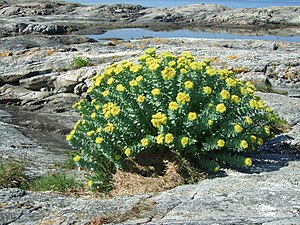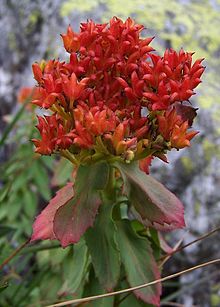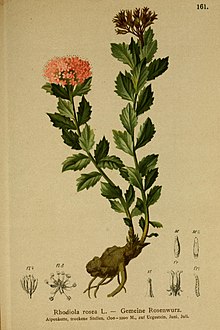Rose root
| Rose root | ||||||||||||
|---|---|---|---|---|---|---|---|---|---|---|---|---|

Rose root ( Rhodiola rosea ) |
||||||||||||
| Systematics | ||||||||||||
|
||||||||||||
| Scientific name | ||||||||||||
| Rhodiola rosea | ||||||||||||
| L. |
Rose root ( Rhodiola rosea ) is a type of plant from the genus Rhodiola in the family of thick-leaf plants (Crassulaceae).
description
Appearance
Rose root grows as a perennial succulent plant and reaches heights of usually 5 to 20, rarely up to 35 centimeters. There are taproots formed. A horizontal or vertical and often branched, 1 to 5 centimeter thick, bulbous, subterranean trunk with a characteristic rose-like odor (hence the German trivial name ) is formed as a permanent organ . From this underground trunk several aboveground stems are formed, which are thick, fleshy and bald and have scales; if they are cut off or injured, the characteristic rose-like odor is noticeable.
Foliage leaves
The alternate, sometimes pseudo-lively, distributed leaves on the stem are sedentary and can only be kept for one vegetation period at most. The thick, succulent, blue-green, simple leaf blade is 10 to 40 millimeters long and 2 to 10 millimeters wide and is obsolete to slightly spoon-shaped. Both leaf surfaces are bare. The row of leaves in front of the inflorescence is entire or slightly serrated.
Inflorescence and flower
Rose root is dioecious, separate sexes ( diocesan ), so there are male and female specimens. The flowers are arranged in dense, clustered inflorescences.
The fragrant, unisexual flowers are radial symmetry and have a double flower envelope . The mostly four, rarely three or five sepals are free. The 1.5 to 2.5 millimeters long, free petals are yellow in the female flowers, red-orange when they fade and purple in the male flowers. There are six to ten or more stamens in the male flowers . In the female flowers there are three to six free ( apocarpic ) upper carpels . Each carpel contains only one or a few ovules .
Fruit and seeds
There are three to six upright follicles together. The hairy, fleshy follicle is elongated-cylindrical with a length of 4 to 6 millimeters and a diameter of 3 to 5 millimeters. The follicle fruit, which is red to light red when ripe, opens from above. The seeds are 0.5 to 1 millimeter long.
Chromosome set
The number of chromosomes is 2n = 22 or 36.
Occurrence
Rose root has a Holarctic distribution. The distribution area includes the arctic areas and the mountainous regions of Eurasia and North America .
Rose root thrives on moist soils in the entire Fjell region up to the upper alpine zone at altitudes of around 2280 meters; grows in mountain gorges, on damp cliffs , on wet meadows and bog soils . The species also occurs on dry, sandy soils in higher mountain areas and in somewhat shaded, snow-damp crevices of the silicate rock . Rose root is a species of the Androsacion vandellii association in Central Europe .
ingredients
The ingredients of the root drug are mainly phenolic glycosides such. B. Salidrosid and Rosavin as well as the aglycon tyrosol . However, the pharmacological effectiveness of certain ingredients has not been precisely proven, and they are mainly used as marker substances for the identification of the raw drug and extracts .
Rose root extracts extend the life span of fruit flies by up to 24%.
Health related use
In Siberia the rose root is called the "golden root" (Золотой Корень, Solotoy Koren) because the root extract is said to increase memory , concentration and absorption. It is also used for problems with erectile dysfunction. Rose root is an adaptogenic medicinal plant that has long been used medicinally in Russian, Baltic and Scandinavian countries, both as a tea and in the form of extracts. In other countries, too, the traditionally based or folk medicine use of preparations of rose root rhizome to increase performance and reduce stress is spreading .
The effects are possibly mediated by changes in serotonin and dopamine levels: for example, via an inhibition of monoamine oxidase , better permeability of the blood-brain barrier for neurotransmitter precursors and an influence on opioid peptides (e.g. endorphins ), including one decreased release of stress hormones is discussed. Insufficient data are available on possible interactions.
In an assessment report, the European Medicines Agency (EMA) evaluated studies on the following areas of application: stress-related exhaustion / fatigue, physical performance , mental / cognitive performance, night shift-related fatigue, sleep architecture, episodes of mild to moderate depression , generalized anxiety disorder . She came to the conclusion that the quality of the studies varied widely and that there was therefore insufficient evidence for therapeutic effectiveness . However, since the results of the clinical studies make the use in certain areas of application plausible and rose root has been used in natural medicine for a long time, the risk-benefit ratio for the application for the temporary relief of stress symptoms such as exhaustion and feeling of weakness is considered in the absence of serious side effects judged positively.
history
Rose root has been in culture at Leonhart Fuchs since at least 1542 . In his Latin herb book from 1542, Fuchs wrote: "Nunc in multis Germaniae hortis plantatur". The translation in his German herbal book reads: "But yetzund bey also planted in gardens". Fuchs also wanted to depict the plant in his herbal books. Since the rose root did not flower before 1542, he could only have sterile plants shown. He wrote in 1543:
"... and that I expect if you want to bring bluomen, that in the first jar you didn’t get it, but only in the other, because I don’t like the dying leüff half to be anheymic."
Fuchs was not present in Tübingen because of a plague epidemic. But he must at least have seen the blossoms, because he wrote on in 1543: “It also winds bluomen, which you didn't have painted at the time when I had it, that's why they were left out. Be on the color gel, and starry, like on the little Haußwurtz mennle ”. The Kleine Haußwurtz mennle is the rock sedum ( Sedum reflexum ). Only in the Ulm hand copy from Fuchs are flowers of the rose root shown. The drawing there is unique and may have been made by Fuchs himself.
literature
- Alain Cuerrier, Kwesi Ampong-Nyarko (ed.): Rhodiola rosea. [Monograph in the CRC series 'Traditional Herbal Medicines for Modern Times']. CRC Press , 2015. ISBN 978-1-4398-8840-7 (print); ISBN 978-1-4398-8841-4 (eBook)
swell
- SG Aiken, MJ Dallwitz, LL Consaul, CL McJannet, LJ Gillespie, RL Boles, GW Argus, JM Gillett, PJ Scott, R. Elven, MC LeBlanc, AK Brysting, H. Solstad: Flora of the Canadian Arctic Archipelago : Rhodiola rosea L. - Online at DELTA. (Section Description and Distribution)
Individual evidence
- ↑ Jaakko Jalas, Juha Suominen, Raino Lampinen, Arto Kurtto: Atlas florae europaeae . Volume 12 Resedaceae to Platanaceae. Helsinki 1999, ISBN 951-9108-12-2 , pp. 124-125.
- ↑ a b Erich Oberdorfer : Plant-sociological excursion flora for Germany and neighboring areas. 8th edition. Verlag Eugen Ulmer, Stuttgart 2001, ISBN 3-8001-3131-5 . P. 482.
- ↑ Michael P. Torrens-Spence, Tomáš Pluskal, Fu-Shuang Li, Valentina Carballo, Jing-Ke Weng: Complete Pathway Elucidation and Heterologous Reconstitution of Rhodiola Salidroside Biosynthesis . In: Molecular Plant . tape 11 , no. 1 , January 2018, p. 205-217 , doi : 10.1016 / j.molp.2017.12.007 .
- ↑ Hsiu-Mei Chiang, Hsin-Chun Chen, Chin-Sheng Wu, Po-Yuan Wu, Kuo-Ching Wen: Rhodiola plants: Chemistry and biological activity . In: Journal of Food and Drug Analysis . tape 23 , no. 3 , September 2015, p. 359-369 , doi : 10.1016 / j.jfda.2015.04.007 .
- ↑ M. Ganzera, Y. Yayla, IA Khan: Analysis of the marker compounds of Rhodiola rosea L. (golden root) by reversed phase high performance liquid chromatography. In: Chemical & Pharmaceutical Bulletin , Vol. 49, No. 4, 2001, pp. 465-7. PMID 11310675
- ^ Herbal Extract Found To Increase Lifespan. In: ScienceDaily. October 12, 2007, accessed December 29, 2013 .
- ^ Samuel E. Schriner, Kevin Lee, Stephanie Truong, Kathyrn T. Salvadora, Steven Maler, Alexander Nam, Thomas Lee, Mahtab Jafari: Abstract: Extension of Drosophila Lifespan by Rhodiola rosea through a Mechanism Independent from Dietary Restriction. In: PLOS ONE. May 21, 2013. Retrieved December 29, 2013 .
- ^ Gregory S. Kelly, ND: Rhodiola rosea: a possible plant adaptogen. In: Alternative Medicine Review . Vol. 6, No. 3 , 2001, p. 293-302 , PMID 11410073 (English).
- ↑ A. Panossian, G. Wikman, J. Sarris: Rosenroot (Rhodiola rosea): traditional use, chemical composition, pharmacology and clinical efficacy . In: Phytomedicine . Vol. 17, No. 7 , June 2010, p. 481-93 , doi : 10.1016 / j.phymed.2010.02.002 , PMID 20378318 (English).
- ↑ Committee on Herbal Medicinal Products (HMPC): Assessment report on Rhodiola rosea L., rhizoma et radix (PDF; 259 kB), March 27, 2012.
- ^ Werner Rothmaler : Excursion flora from Germany . Volume 5: Herbaceous ornamental and useful plants. Page 330. Springer-Verlag Berlin, Heidelberg, 2008. ISBN 978-3-8274-0918-8
- ↑ Leonhart Fuchs : “De Historia Stir- || pivm commentarii insignes, ma || ximis impensis et vigiliis ela || borati, adiectis earvndem vivis plvsqvam || quingentis imaginibus, nunquam antea ad naturae imitationem artificiosius effi- || ctis & expressis, Leonharto Fvchsio […] ”, Basel 1542, page 664.
- ^ A b Leonhart Fuchs : “New Kreüterbuch”, Basell 1543, Cap. CCLXXIII.
- ^ A b S. Seybold: News about Leonhart Fuchs . In: Annual Ges. Naturk. Württ. 157, Stuttgart 2001. Pages 146-147.
- ↑ A hand copy from Ulm by Fuchs in 1543 scanned in at “publications.uni-tuebingen”.
Web links
- Rhodiola rosea L., real rose root. In: FloraWeb.de.
- Profile and distribution map for Bavaria . In: Botanical Information Hub of Bavaria .
- Rose root . In: BiolFlor, the database of biological-ecological characteristics of the flora of Germany.
- Rhodiola rosea at Plants For A Future
- Rhodiola rosea L. In: Info Flora , the national data and information center for Swiss flora . Retrieved October 30, 2015.
- Distribution in the northern hemisphere according to Eric Hultén
- Thomas Meyer: Data sheet with identification key and photos at Flora-de: Flora von Deutschland (old name of the website: Flowers in Swabia ).
- Literature on Rhodiola rosea in the Kew Bibliographic Databases.
- PTA forum: Plant portrait.
- Phytodoc : Detailed information on the medicinal plant rose root.


